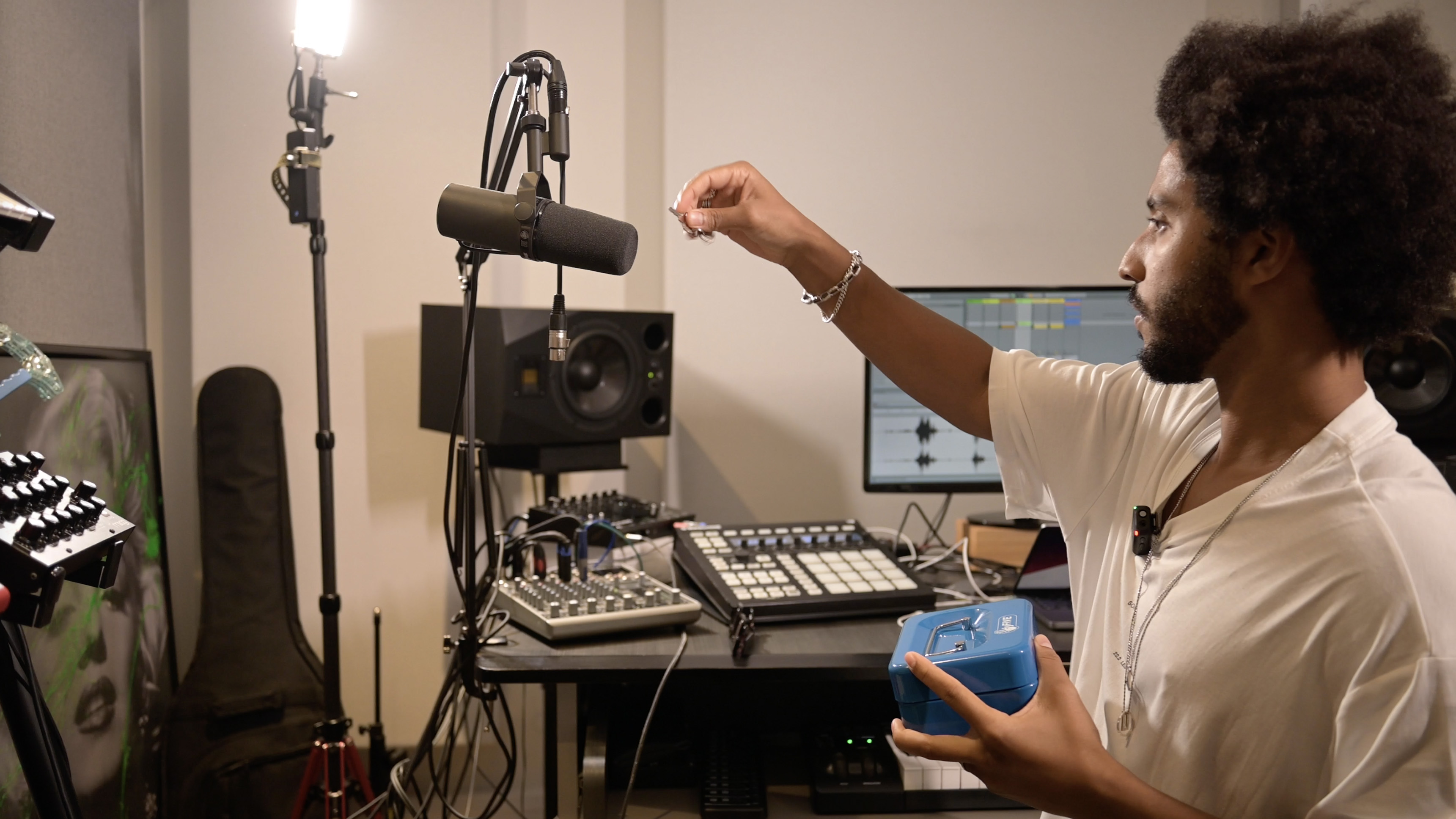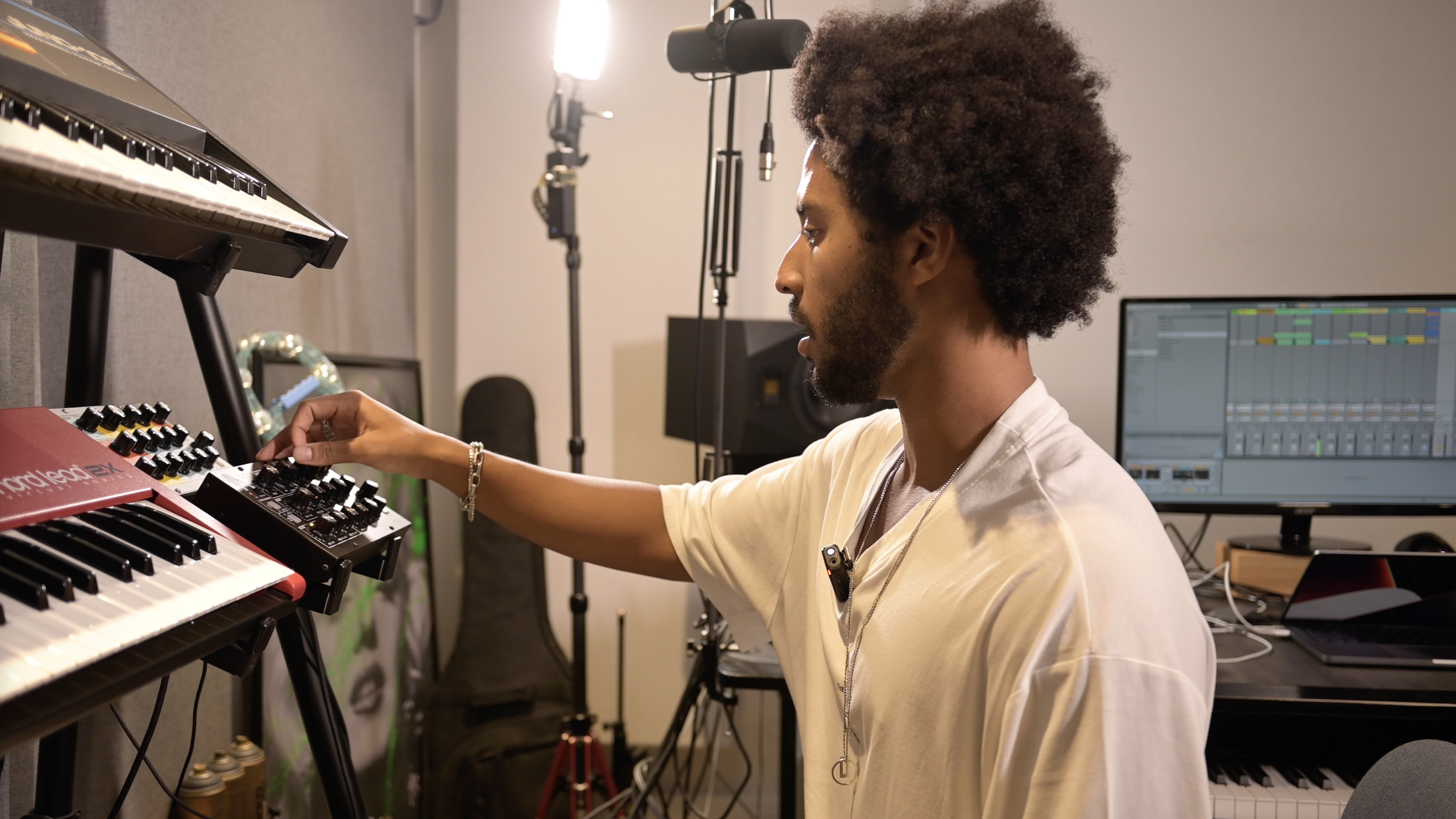London-based producer Hardt Antoine has an artist name that pays tribute to his French and West Indian heritage, and a sound that, while rooted in the drum machine grooves of house and techno, pulls influences from soul, hip-hop, IDM and beyond.
Originally breaking through as a DJ before learning to produce tracks of his own, Antoine made his name, in part, through founding Reculture, a popular series of parties in his home town of London. Since 2020, Reculture has shifted focus towards becoming a label and Antoine has put increased emphasis on his own productions, resulting in releases on labels including Innervisions and Kompakt.
To get an insight into how Antoine’s tracks come together, we visited his London studio and challenged him to sketch out a track from scratch. In the video above, he walks us through his standard workflow, which makes use of a mix of sampling, Ableton Live and hardware synths, but also eschews organisation and preparation in favour of unfettered creativity – in a manner that may give some more orderly-minded musicians heart palpitations.
We collected the five most insightful workflow tips from our session with Hardt Antoine, which you can watch in full above.
Start with a blank slate and an open mind
For some producers, pre-made project templates and go-to presets are an invaluable creative timesaver, but Antoine prefers to start with an entirely empty project and nothing pre-prepared.
“Normally I start with a completely blank canvas, an empty Ableton set,” he explains. “I’ve got no presets, no template, nothing like that. The reason why is because I don’t like process, I don’t like starting a track with a kick drum, or a snare, or a hat. I don’t like having a certain way of doing things, for me that’s kind of like the enemy of creativity. My [project] is always blank so I can keep an open mind and go absolutely anywhere.”
Antoine prefers to separate his creative workflow into different stages, the first being about pure creativity, while arrangement and mixing considerations come later. He uses Live’s two views as a way to delineate between these.
“I’m working in the Live Session view,” he tells us. “I always start tracks like this and use it as my sketchpad. Once I’m happy with something, I’ll switch to the Arrangement view and put everything together in there.”

Use simple recording to work around your sound design weaknesses
We all have certain sounds we find harder than to create from scratch than others. For Hardt Antoine, it’s metallic tones that prove tricky. His solution is to keep some appropriate-sounding objects close to hand in order to record samples using a simple mic setup whenever they’re needed.
“I’ve got a safe full of coins and some keys,” he says. “The reason I use these is because the thing I always struggle with is metallic sounds. These are beautifully metallic.”
The idea is to keep the process quick, rough and ready. Rather than trying to create a pristine recording, he looks for inspiration in spontaneous, imperfect recordings.
“I just hit record on the mic and record a bunch of crap and then turn it into something,” he says. “I’m not making clean recordings, I’m just kind of jamming.”
For our session, he captures some loops of keys, coins and his own voice, even embracing imperfections like mic feedback. He then loads the results into Ableton Simpler and slices out a few characterful percussion sounds, as well as some vocal syllables.
“I’ll probably make five things out of that one little recording,” he explains.
Park the processing to avoid latency
"I don’t like to do too much processing too early as then you’ll get latency, latency and hardware are not friends."
Hardware synths play a major part of Antoine’s workflow, and his Moog Taurus, Juno-106, Prophet-6 and Nord Lead all provide sounds for his track sketch. He incorporates these directly into the Ableton project by sending MIDI back and forth.
“The way I’m working is I’m running MIDI into the synths from Ableton using the External Instrument device,” he tells us. “That way I can use the MIDI from Ableton, the clocks and the piano roll – essentially use it as a plugin. Afterwards I’ll take audio from the synth and record it back into Ableton.”
One thing he avoids, at this early creative stage, is applying much in the way of software processing, beyond a little rhythmic delay.
“I add a little delay onto the bass, which is a little signature of mine. I’m removing all of the low frequencies from the delay, then I’ll just play with the delay settings until I find something that sits nicely with the rhythm.”
He sticks to simple stock delay and reverb devices placed on effect sends, the reason being to minimise latency, which can derail the creative flow when working between software and hardware.
“Later I’ll probably sidechain the delay to the kick,” he tells us. “But I don’t like to do too much processing too early as then you’ll get latency, and latency and hardware are not friends. I’m not mixing [the delay at this stage], just getting rid of a bit of low-end using a low-cut filter. When I mix the track, I’ll think more about all of this. Right now I just want a little delay on the bass that isn’t causing problems.”

Organisation can kill creativity
There’s a notable lack of renaming and organisation going on in Hardt Antoine’s Ableton Live project but, he insists, this is a deliberate tactic to avoid repetition and encourage ‘happy accidents’.
For one thing, despite keeping several hardware synths patched into Ableton Live, he purposely doesn’t name the audio or MIDI channels coming in and out of his interface – something other producers might see as an essential time-saver.
“I could get very organised and label everything, but I don’t, for two reasons. Firstly, because I’m rewiring everything all the time, as I’m always moving [gear] around if I get bored. The other reason is because I want a bit of randomness; I want to make mistakes. I want to think I’m playing one synth and actually be playing another one.
“All that stuff is the kind of anti-process stuff I’ve been talking about,” he continues. “If you’re doing your accounts then organisation and process is good, if you’re making art it’s good to work a bit blind and a bit weird. That’s how you get your happy accidents.”
The same goes for the recordings and patterns he creates within Live itself, which are left unnamed and unorganised.
“I haven’t labelled anything yet, I’ll do all of that later,” he explains. “When I come to arrange the track, the first thing I’ll do is organise the page, but right now mess is good! Mess means randomness, mess means spontaneity. It’s not worth spending ages organising the page and losing the creative flow.”
Tighten up drums with guitar processing
To add his personal stamp to the work-in-progress track, Antoine records some stuttering snare rolls, which are a signature element of his sound. He does this by throwing a TR-707 sample into Ableton’s Simpler, and then recording a pattern using his MIDI keyboard.
To quickly get the snare sounding how he likes it, he reaches for a go-to effect chain saved in Native Instruments Guitar Rig (an notable exception to his no-templates policy).
“I’ve got this chain that I’ve made using Guitar Rig. You’ve got reverbs and amps and all sorts of things. This chain I use has some guitar [amp] processing, with some reverb and compression”
He loads the effect across the snares to quickly tighten up the snare roll sound. He also adds a touch of reverb before distortion and compression, to give it extra character.
“I’ll often put a reverb in before the guitar processing,” he tells us. “I’ll use a slightly different reverb to the one I’ve used elsewhere in the track, to make [the snare] sound more like a sample.”







